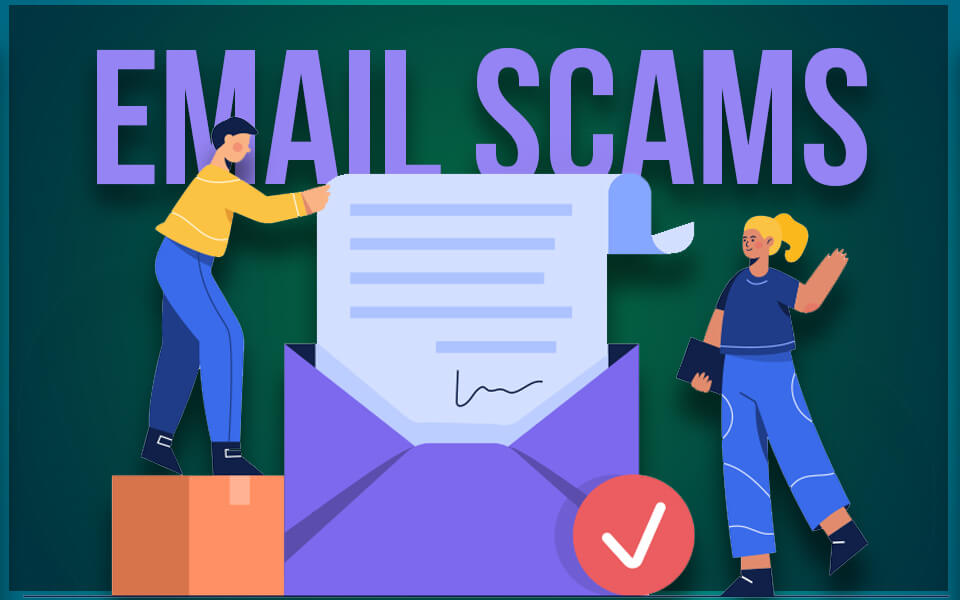
Emails are a convenient and powerful way to communicate. Unfortunately, it also provides fraudsters and other suspicious victims with an easy way to steal money from the victims. The scams they operate are usually in the bit and switch operations to phishing schemes utilizing a combination of emails and bogus websites to mislead victims. Email is an inexpensive and popular method for distributing scam messages to potential victims. To protect yourself from these email scams, you need to know what they are, how they operate, and what you can do to prevent them.
In This Article
- What are Email Scams?
- Common Email Scams
- How do you recognize Email Scams?
- How do you avoid Email Scams?
- How to protect yourself from an Email Scam?
- How to report email scams?
- How To Inform If An Email Is From a Scammer?
- How to get your money back from Email Scams?
- Why is Scam Recovery Expert a trusted name in the world of Email Scams Recovery?
- Why Choose Us?
What are Email Scams?
An email scam is the deliberate use of deception to harm another person via email. Email started to be a means of scamming individuals almost as soon as it became popular. Scams or “con games” are two instances of email fraud. Confidence tactics frequently exploit the innate greed and dishonesty of their victims. The promise of a “deal” or “something for nothing” can be immensely alluring. Email scams, like other schemes, typically prey on unsuspecting people who have faith in get-rich-quick plans. These include investments that seem “too good to be true” or offers to sell well-liked goods for “impossibly low” prices. Because of fraud, many people have lost their entire life savings.
Common Email Scams:
Email phishing scams:
Phishing is a kind of social engineering in which an assaulter delivers a false message intended to dupe a person into giving sensitive information to the attacker or installing harmful software, such as ransomware, on the victim’s infrastructure. Some fake messages come from an established business, possibly one with which the intended victim already has business ties. In this case, the “bait” could be a message purporting to be from “the fraud department” of the victim’s bank, asking the client to check their details, login to their account, establish a unique password or other similar necessities. They are led to a page that looks the same but has a different URL than the website they trust.
Their login and password are available to the perpetrators once they have entered their login information. Often, phishing emails seem innocent, like a message informing the recipient that they have a new friend request on a social media platform. However, no matter how ignorant the message may appear on its own, it will always direct the victim to a fake website and a fake login screen.
Check cashing schemes:
In this kind of Email, the con involves the sender asking you to cash a check to keep a share of the proceeds. For instance, the message may read, “I’ll send you a $10,000 cheque that is made out to you. You only need to deposit it. You can keep $1000 and wire $9,000 back to me in exchange for completing this.”
Typically, emails are used to spread this hoax, but job listing websites can also be a source. Both the original check and the con artist are usually from abroad. The check might appear genuine, and the offer might be alluring. However, in reality, there is no checking account, or there is not enough money in the account to claim the check. Funds may be available for transfer prior to the arrival of the incoming check due to the result of the check-clearing process. In this Email scam, the victim wires the money to the perpetrator and then learns that the check has bounced a few days later. As a result, $10,000 is lost.
Lottery winnings scams:
The lottery email scam is another fraud that promises quick money and affects people’s sense of luck. You’ll receive an email saying you’ve won the lottery. The email can even refer to a reliable lottery firm. It often instructs you to contact a claims agent to claim your wins while requesting you to keep the winnings a secret for the time being. Before you receive your lottery money, the “claims agent” will want money to pay taxes, legal expenses, or other processing costs. However, reputable lottery firms do not impose a fee before you get your winnings.
Spoofing emails:
Spoofing is the technique of sending emails to a person pretending to be someone else. Spoofing can happen in a variety of ways. However, they all share the trait of hiding or masking the sender’s identity and the message’s source from the recipient. Most email fraud cases involve spoofing, and since most frauds are illegal, offenders usually strive to avoid being easily tracked down.
Fake Email Offers:
Email offers to buy products or services could be an example of attempted fraud. A widespread good or service is provided fraudulently at a steep discount or items are advertised before they become available. For instance, the most recent video game might be sold before its official release at a similar price. Instead of a price decrease, the “greed element” in this situation is the desire to have something that no one else has before it is available to everyone else. Naturally, as it was never an actual offer, to begin with, the item is never delivered.
Such an offer is nothing more than a phishing attempt to obtain the victim’s credit card information to use it to fraudulently purchase goods or services. The victim might not realize they were scammed until their credit card has been “used up.”
How to recognize email scams?
Because they are so sophisticated, socially engineered phishing emails frequently slip through email filters. They are rarely transmitted in bulk from blocklisted IP addresses to avoid being blocked by real-time Blackhole Lists, have the proper Sender Policy Frameworks and Simple Mail Transfer Protocol (SMTP) restrictions, and pass the filter’s front-end checks. They can even elude detection from sophisticated email filters because they are often uniquely created. On the other hand, phishing emails usually share some similar traits; they are frequently written to arouse emotions like curiosity, pity, fear, and greed.
Emails requesting immediate action:
Phishing emails frequently contain threats of adverse outcomes or missed opportunities unless immediate action is taken. Attackers often employ this strategy to pressure recipients into taking action before they have had a chance to read the email for any potential errors or inconsistencies carefully.
Emails with errors, especially grammar and spelling mistakes:
Poor grammar and spelling are other indicators of phishing. Many firms automatically spell-check outgoing emails to be confident that they are grammatically correct. In addition, users of browser-based email clients use web browser autocorrect or highlight functions.
Emails with an unusual salutation or greeting:
Typically, emails sent and received between colleagues begin with an informal greeting. Those that start “Dear” or contain words that aren’t often used in everyday conversation come from people who aren’t familiar with workplace communication in your company and should raise concern.
Unreliable Links, Email Addresses, and Domain Names:
Finding irregularities in email addresses, links, and domain names is another approach to recognizing Email scams. Does the sender of the Email regularly correspond with that firm? If so, compare the sender’s address to those on earlier emails from the same firm. Hover the mouse pointer over a link to see what appears to determine whether it is accurate. Report the Email as a phishing attack if it purports to be from Google, but the domain name says something else.
Doubtful Attachments:
Collaboration technologies like SharePoint, OneDrive, or Dropbox are used for most work-related file sharing. Therefore, internal emails containing attachments should always be considered suspicious, especially if they have an unknown extension or one frequently linked to malware.
Emails asking for login credentials, payment details, or sensitive information:
Extreme caution should always be exercised when receiving emails that ask for login credentials, credit card information, or other sensitive information from an unexpected or unfamiliar sender. Spear phishers can create phony login sites that resemble the genuine article and then send an email with a link that takes the receiver to the false page. Suppose a recipient is sent to a login page or informed that payment is required. In that case, they should not enter any information unless they are positive the Email is authentic.
Too Good to Be True Emails:
In emails that seem too good to be true, the sender entices the receiver to click a link or open an extension by promising a bonus of some sort. It’s likely a phishing email if the sender of the Email is unknown or if the recipient does not initiate contact.
How do you avoid Email Scams?
We can never be entirely safe from phishing, which is terrible news. The good news is that you have many options for safeguarding your Email and private data. Here are some valuable tips to secure your Email against Email scams:
- Use specialized cyber security software to keep your data secure:
You have an additional layer of protection and peace of mind when you have reliable security software. - Set up two-factor authentication for your online accounts:
With two-factor authentication, you will also be required to enter a security code that was delivered to your phone in addition to your password. Although it takes longer, it makes it much more challenging to hack into your account. - Secure your browsing with a VPN:
You can conceal your location or financial information using a VPN (Virtual Private Network), which encrypts all the data you send. It’s similar to sending encrypted communication over the internet; only the intended receiver has the key to decipher it. This makes it impossible for hackers and phishers to watch your online activities. - Make sure you update your browser with the most recent versions:
We know that updates arrive when you cannot install them. However, they are designed for a reason—possibly because the software developer identified security flaws in their system and developed remedies to strengthen security.
How to protect yourself from an Email Scam?
To prevent falling for phishing schemes, adhere to these methods and best practices:
- Maintaining current anti-virus software and doing frequent computer scans will safeguard your machine.
- Your mobile phone’s software should be updated automatically to protect it from malware and viruses.
- One of the best methods to protect your accounts is via multi-factor authentication. Some versions provide extra protection by needing two or more authenticators to log in, such as those at specific banks. Multi-factor authentication is what this is.
- Create a backup of your data to protect its security. Please make sure you have several data backups and that none of them are connected to your home network.
- Never divulge your password to anyone.
- Open no unforeseen attachments. Hackers use them to send viruses or malware.
- Don’t just randomly click links. By using your mouse to hover over a link and carefully reading the language, you can ensure if it is the right one.
- Don’t log in if you click on an unauthorized link and are instantly taken to a sign-in page.
- It’s seldom true if something sounds too good to be true.
By adhering to these recommendations you can protect your data and stay one step ahead of the phishers.
How to report email scams?
Email scams arrive in the inboxes of almost everyone with a working email address. At best, those who fall for these tricks experience annoyance; at worst, they suffer catastrophic financial and personal loss. Reporting email scams helps catch the criminals behind them and keeps others from falling for them.
- Scam Recovery Expert will track down the thieves and take legal action against them if you send them any scam emails or unwanted emails.
- Make contact with the business that the email hoax purports to be from. Although they frequently contain harmful code that can transfer passwords and other confidential information to scammers, many scam emails appear to come from reputable sources. By reporting these emails to the company, you may help them stop these scams.
- Keep in touch with your Internet service provider at all times so they can help protect you against phishing emails. The majority let you directly forward these emails to them from your inbox.
- To keep your email list safe from scammers, double-check your emails before sending them. Email integrity can be easily verified, you can prevent it from gaining traction by avoiding forwarding it to your friends if it is a hoax.
- By posting your experiences on websites like those available on Craigslist, Yahoo, Snopes, or Urbanlegends, you can educate others about email frauds. Your knowledge will help assist others.
How To Inform If An Email Is From a Scammer?
Look at seven things you should be conscious of and watch out for when trying to tell email phishing from authentic email. Be cautious if:
- The sender domain name is the same as the public domain title.
- The scammer’s domain name is completely wrong or maybe misspelt.
- The Email is poorly written with grammatical or spelling mistakes.
- The tone of the emails will urge you to act quickly
- Dubious attachments or links
- The emails promise guaranteed returns or unexpected offers.
How to get your money back from Email Scams?
Anyone can fall for an email scam. Passwords, account details, place of living, and other sensitive information are obtained through phishing emails. It’s a terrible crime that might make you uneasy or anxious.
As a pioneer in the industry, Scam Recovery Expert can give you the assistance and support you need after falling for a con. We are specialists in recovering from email scams in addition to recovering from bitcoin, binary options, and credit card losses. We have gained the faith and respect of our clients thanks to our 90 percent success rate, illustrious legal connections, and efficient analytical techniques. Our innovative fund recovery approach is entirely to blame for this.
Why is Scam Recovery Expert a trusted name in the world of Email Scams Recovery?
If you think you have accidentally given an email scammer access to your account information, get in touch with Scam Recovery Expert immediately.
Although becoming an Email scam victim can be tremendously upsetting, support is available in several ways. One such reputable firm that assists victims in legally thwarting fraud and recovering their money is Scam Recovery Expert. Our consultants, therefore, get in touch with you and offer free emotional and practical support when you report fraud to us. Additionally, we use our expertise to reclaim your lost funds. Scam Recovery Expert has a strong track record and a high success rate.
Why Choose us?
Scam Recovery Expert is one of the best chargeback businesses in the globe. We take great pleasure in having the highest industry success rates and are experts in recovering from internet trading frauds.
Choosing Scam Recovery Expert means choosing a team that will work diligently on a careful analysis of your case, compile the evidence, deal with scammers on your behalf, and offer free advice.
FAQs
Using proper tools and safeguards will help protect your business from email-based scams. Here are a few suggestions to avoid email scams:
- Install secure software
- Constantly update your security, operating system, and internet browsers and applications.
- Always schedule regular backups.
- Set a solid password for your account.
- Use Multi-factor authentication.
Fraudsters can get into the email address through a database leak or brute force attacks. Once they gain access, they can do anything with your account.
- They can impersonate you with the help of your mail.
- They can easily break the password of your other accounts.
- They can also use this to break email-based two-factor authentication.
- They can also collect sensitive details related to bank details.
- They can even steal your identity.
Knowing how to recognize email scams is essential. If you find suspicious emails or have fallen for them, contact Scam Recovery Expert, where our experts will help you until you receive your money back from the scammers.
- The legal organizations send emails from the email address containing the firm name after the @ symbol. So, carefully check the domain name before opening the mail.
- Never ignore unusual spelling or grammatical mistakes.
- Please pay attention to the language used in the mail if they are showing any urgency or fishiness.
- Always check the email Bcc section.
These can help to identify if an email is genuine or fake.
Have you wrongfully trusted Email scams? If so, contact Scam Recovery Expert, where our fund recovery team will help you to recover your funds from scammers.


